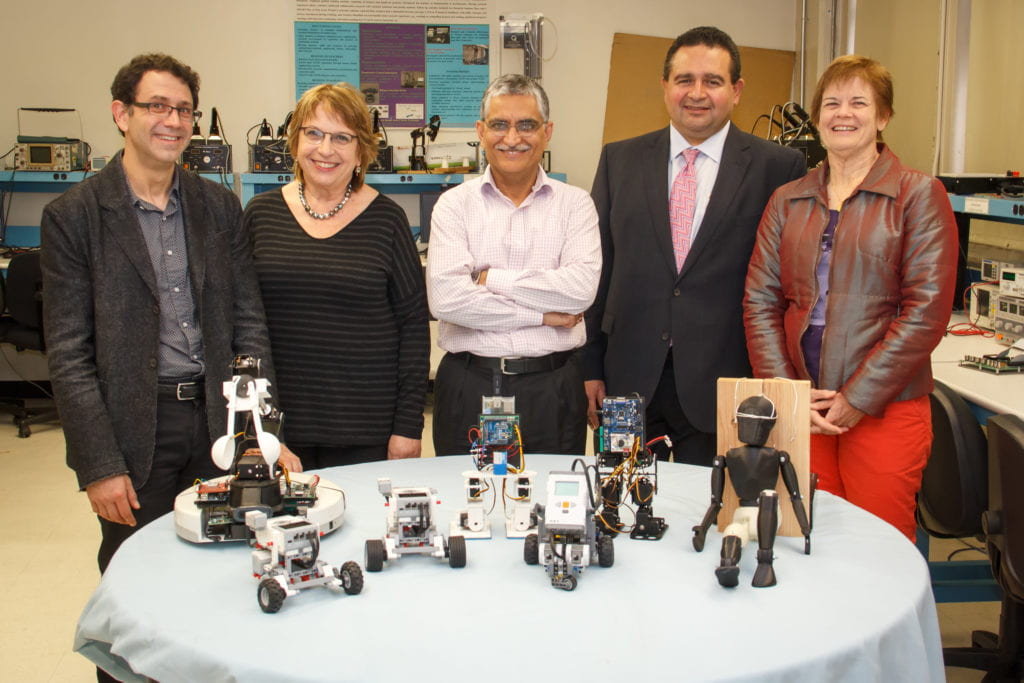DRK12
DR K-12: Teaching STEM with Robotics: Design, Development, and Testing of a Research-based Professional Development Program for Teachers
Offering meaningful and motivating engineering contexts, such as robotics, within science and math courses constitutes a compelling strategy to address the Next Generation Science Standards and the Common Core State Standards for Math while enhancing science and math learning for all students. Using design-based research, with teachers as design partners, the project will create and refine project-based, hands-on curricula such that science and math content inherent in robotics and related engineering design practices are learned. To provide teachers with effective models to capitalize on robotics for elucidating science and math concepts, a design-based Professional Development program will be built using principles of technological, pedagogical, and content knowledge (TPACK). To ensure that teachers are well prepared, research-based practices and features of effective Professional Development will be adopted. Experts in robotics, engineering, education, curriculum design, and assessment–with experience in K-12 education, training, and outreach–have formed an interdisciplinary team to make robotics central to and sustainable in middle school science and math classrooms.

The research questions addressed in this project are qualitative in nature as appropriate for design research questions. The methodologies include teacher needs assessment, teachers’ perceptions of robotics, pre and post testing, classroom observations, and surveys. Examples of the research questions are:
- What characteristics of robotics promote effective learning of middle school science and math?
- What elements of Professional Development engender teachers’ TPACK of robotics and link it with classroom science and math?
- What are student prerequisites to effectively use robotics in science and math learning?
- What are the gains in students’ STEM engagement, interest, persistence, and career awareness?
The robotics curriculum will include physical science used in robot performance expectations and motion stability. Additionally the curriculum will include the engineering design process consisting of problem definition, solution development, and design improvement. Robotics provides opportunities to support science and engineering practices of the Next Generation Science Standards such as developing and using models, planning and conducting investigations, designing solutions, and analyzing and interpreting data. The project will be aimed at middle school students and will provide substantial teacher professional development to implement the new curriculum modules. The partner schools have student bodies drawn from a diverse student population in New York City.
For more information, please visit the project web site located at
http://engineering.nyu.edu/mechatronics/DRK-12/
Publications
- J.A. Frank and V. Kapila (2015) “Using Tablets in the Vision-Based Control of a Ball and Beam Test-bed,” Proc. Int. Conf. Informatics in Control, Automation, and Robotics, Colmar, Alsace, France, 10 pages [link]
- J.A. Frank, A. Brill, and V. Kapila (2015) “Exploring the Role of a Smartphone as a Motion Sensing and Control Device in the Wireless Networked Control of a Motor Test-bed,” Proc. Int. Conf. Informatics in Control, Automation, and Robotics, Colmar, Alsace, France, 9 pages [link]
- A. Brill, J. Listman, and V. Kapila (2015) “Using Robotics as the Technological Foundation for the TPACK Framework in K-12 Classrooms,” Proc. Amer. Soc. Eng. Ed., Seattle, WA, 20 pages [link]
- M. Moorhead, J. Listman, and V. Kapila (2015) “A Robotics-Focused Instructional Framework for Design-Based Research in Middle School Classrooms,” Proc. Amer. Soc. Eng. Ed., Seattle, WA, 19 pages [pdf]
- V. Siderskiy, A.A. Mohammed, and V. Kapila (2015) “Chua’s Circuit for Experimenters Using Readily Available Parts from a Hobby Electronics Store,” Proc. Amer. Soc. Eng. Ed., Seattle, WA, 15 pages
- R.G. Yadagiri, S. Krishnamoorthy, and V. Kapila (2015) “A Blocks-based Visual Environment to Teach Robot-Programming to K-12 Students,” Proc. Amer. Soc. Eng. Ed., Seattle, WA, 12 pages [link]
- J.A. Frank and V. Kapila (2015) “Path Bending: Interactive Human-Robot Interfaces With Collision-Free Correction of User-Drawn Paths,” Proc. ACM Int. Conference on Intelligent User Interfaces, Atlanta, GA, pp. 186-190 [link]
- J. A. Frank, Y. Sahasrabudhe, and V. Kapila (2015) “An Augmented Reality Approach for Reliable Autonomous Path Navigation of Mobile Robots,” Proc. Indian Control Conference, Chennai, India, 7 pages
